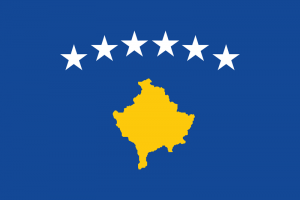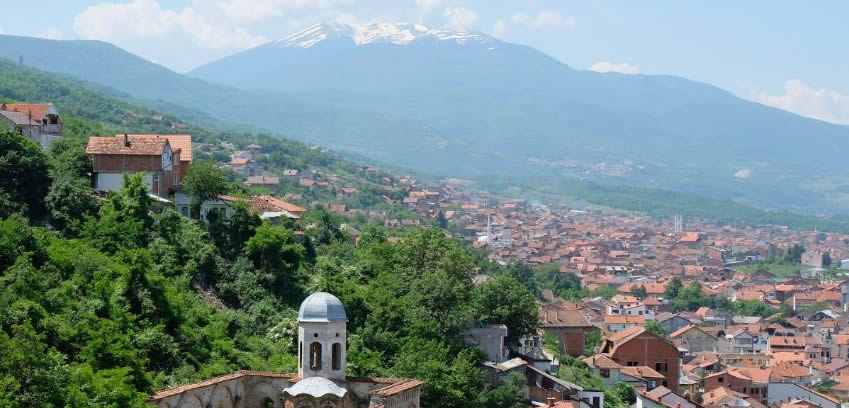Language/Serbian/Culture/Kosovo-Timeline
Jump to navigation
Jump to search
Rate this lesson:
Historical Timeline for Kosovo - A chronology of key events
Kosovo Timeline[edit | edit source]
● Between the Ottoman Empire and Serbia[edit | edit source]
- 1945: after the Second World War, the Kosovar territory, incorporated in 1941 into a Greater Albania under the tutelage of fascist Italy, is included in the Yugoslavia of Marshal Tito as an autonomous province of the Socialist Republic of Serbia, one of the six States forming this communist federation. Kosovo, populated by a majority of Albanians and a large Serbian minority, had already been attached to the Kingdom of Serbia in 1913 after the defeat of the Ottoman Empire, which had controlled this territory since the 14th century. For Serbs, Kosovo has been their historical birthplace since the 11th century.
- 1989: the new Serbian president, Slobodan Milošević, drastically reduces the autonomy of the province of Kosovo by modifying the Constitution, which triggers a revolt of the Albanians, who then represent nearly three quarters of the population. The same year as the fall of the Berlin Wall, this protest was initially carried out without violence under the leadership of Ibrahim Rugova, founder of the Democratic League of Kosovo (LDK) and nicknamed the "Gandhi of the Balkans" for his pacifism.
- 1992: after the dissolution of the USSR at the end of 1991, the republics of the Eastern bloc take their independence. If communist Yugoslavia, neutral since 1948, was not part of it, it is no exception to this movement and explodes with the declarations of independence of Slovenia, Croatia, Bosnia-Herzegovina and Macedonia, which gave rise to several deadly wars until 1995. Yugoslavia remained as a “Federal Republic” until 2003, but only included Serbia (including Kosovo) and Montenegro, which gained independence in 2006.
● The war years[edit | edit source]
- 1996: it is the beginning of the conflict between Serbia and Kosovo, with the creation of the Kosovo Liberation Army, better known by its acronym UÇK which recovers in 1997 a large stock of weapons from Albania.
- 1999: after the failure of negotiations in Rambouillet, NATO carries out an air bombing campaign. Operation Allied Force lasts from March 24 to June 8, when Serbian forces withdraw from Kosovo. The UN Security Council votes on June 10 on resolution 1244 which provides for a peacekeeping operation through an international force, KFOR, controlled by NATO, and the Interim Administration Mission United Nations in Kosovo. Kosovo thus becomes an international protectorate under a UN mandate. During this war, the civilian losses were numerous, an international study of 2008 establishing the list of 13,472 victims (including 9,260 Albanians and 2,488 Serbs). For the NGO Human Rights Watch, the NATO strikes killed around 500 civilians.
● Towards independence[edit | edit source]
- 2005: Former Finnish President Martti Ahtisaari receives a UN mandate to oversee negotiations between Belgrade and Pristina. From the withdrawal of Serbian troops and the arrival of KFOR, Kosovo saw no real status. Resolution 1244 creates provisional institutions under international supervision, but reiterates its attachment to the territorial integrity of the Federal Republic of Yugoslavia (now Serbia), which creates confusion in international law since this resolution is still in force. Moreover, northern Kosovo, made up of a majority of Serbs, is de facto controlled by the Republic of Serbia.
- 2006: Ibrahim Rugova, president of the Kosovar province since 1992, dies of lung cancer after having escaped a bomb attack the previous year. Leader of the LDK and supporter of non-violence, he opposes the Democratic Party of Kosovo (PDK), the political branch of the KLA, which wins the legislative elections of 2007.
- 2007: Martti Ahtisaari submits to the UN Security Council his proposals on the final status of Kosovo, planning to grant it the status of independent state "under international supervision". His project is supported by the United States, but rejected after the veto of Russia and China.
- 2008: on February 17, the provincial parliament proclaims the independence of Kosovo, desired by Prime Minister Hashim Thaçi, leader of the PDK and former head of a criminal military organization, the Drenica Group. The United States and several European countries, including France, recognize this independence. The European Union is sending a security and justice mission to Kosovo called “Eulex”.
● Pending questions[edit | edit source]
- 2010: a Council of Europe report estimates that organ trafficking was organized between 1999 and 2001 by certain members of the KLA, in particular the Drenika group, led by Hashim Thaçi. Prisoners, mostly Serbs, were reportedly kidnapped and then deported and killed in Albania, before their organs were sold. It was also in 2010 that the International Court of Justice ruled that Kosovo's declaration of independence was not illegal.
- 2012: Kosovo gains full sovereignty, with international supervision officially lifted.
- 2018: among the 193 United Nations Member States, 144 have recognized Kosovo, however two permanent members of the Security Council - Russia and China - are opposed to it, which is also the case for five EU countries, in particular Spain, in touch with Catalan independence. This year is also marked by the opening of a special ad hoc court, placed under the judicial authority of Kosovo, but whose magistrates are international judges sitting in The Hague. To remedy the shortcomings on the Kosovar case of the International Criminal Tribunal for the former Yugoslavia (ICTY), which closed its doors in 2017, it will judge the crimes committed during the War, in particular those perpetrated by the KLA. Such an initiative could destabilize the political class up to the highest state level, since Hashim Thaçi, former head of the Drenika Group, was elected President of the Republic in 2016.
Source[edit | edit source]
- https://fr.wikipedia.org/
- https://www.petitfute.com/
- https://www.lefigaro.fr/international/2018/02/17/01003-20180217ARTFIG00018-les-grandes-dates-de-l-histoire-mouvementee-du-kosovo.php
World Timelines[edit source]
Other Lessons[edit | edit source]


